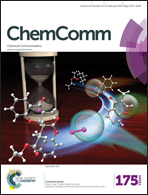Artificial tongue based on metal–biomolecule coordination polymer nanoparticles†
Abstract
We construct an array-based recognition system (the so-called artificial tongue) through the self-assembly of nucleotides, dyes and lanthanide ions. Metal ions are selected as model analytes for verifying its discrimination ability. The work provides valuable insights into the application and development of biomolecule-based materials.


 Please wait while we load your content...
Please wait while we load your content...